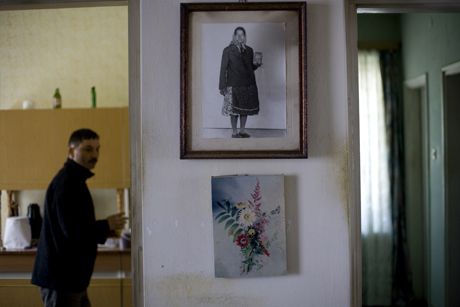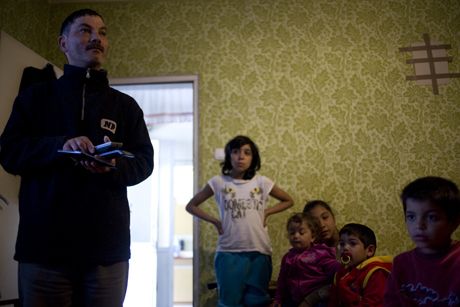In the narrow vestibule of Tibor Orsos’s new house there is a framed, black-and-white photograph. It shows a middle-age woman, standing full height, in a flowery dress, apron and dinner jacket. She wears a headscarf and trainers. A lit cigarette dangles from her mouth. She is looking straight into the camera, resolute in her nonchalance. Her right hand is hanging slack by her side. In her left she holds a one-kilo pack of detergent.
This is Tibor Orsos’s mother. She died in the 1980s, but was recently saved from a second death. In October 2010, during the Ajka alumina plant disaster, red mud inundated Tibor’s house, destroying his few precious possessions: a mattress, a pile of clothes, chairs, a VCR, a plastic statuette of the Virgin, a nativity scene diorama, an oven, Hungarian translations of Shakespeare and Somerset Maugham. Only the photographs on the walls, too high for the flood to reach, survived.
Tibor is a Romani Hungarian--or just gypsy, as he refers to himself. Segregated or forcefully assimilated, killed or tortured, reviled or ignored, the Roma of Hungary have nevertheless persevered through the centuries. Even the flood of toxic red mud, which completely destroyed their quarter in the town of Devecser, could not dissolve their spirit. They’ve endured – and Tibor is one of the hardiest survivors.
You wouldn’t know it from his looks. His 36-year-old face is heavily freckled, like a child’s, and his eyes are a light, almost transparent baby blue. There is something effeminate in his voice and the way he holds his Sopianae cigarette. Even his bushy, grizzled mustache looks soothing. But Tibor is as tough and resolute as his mother. Though he sweeps the streets of Devecser during the day, listlessly, like so many of his neighbors, in the evenings he turns into a passionate musician, a proud heir of Romani culture and traditions. Together with his band, Flare Beas, he has performed in places as far as Warsaw and Istanbul. Music is Tibor’s life.
It is the first thing he shows me when I enter his new house: the photographs of his band, the CDs they recorded, the diplomas from music festivals they received, the articles clipped from local newspapers that mention the band – precious objects that were luckily spared destruction. He plans to put them up on the walls one of these days. Then, in his half-empty bedroom, furnished with just a mattress, an old closet, and a TV (donations from the Red Cross), he puts on one of his band’s concerts. Traditional Romani music fills the room.
At that moment a few neighbors' kids, who had gotten word about the visiting journalists, come in and the bedroom is abuzz with chatter. The faded green wallpaper and blue curtains come to life. The memory of the red flood is momentarily forgotten.
This is what Tibor misses most about the old Roma quarter: the community. There, he was never too far from his brothers and sisters, brothers-in-law and sisters-in-law, from his friends. There, every day was a party, everybody singing, dancing, quarreling, laughing. The neighbors would cook something and bring him a full plate. He would borrow money when he didn’t have any, or lend it when he had some extra. And now--now he has a new house, but most of the time it feels somehow empty.
He is not ungrateful though. The greatest irony of the red-mud sludge in Hungary is that, though it destroyed so much--lives and property and environment--it also gave a chance to those who had nothing to start their lives anew, on a clean slate, in a new house, in a new neighborhood. Born in a segregated quarter at the bottom of the hill, raised in abject poverty, the Roma of Devecser never stood a ghost of a chance to move up. After the disaster, the Hungarian government was obligated to provide them with housing in other, better neighborhoods. The flood, perversely, became a force of social integration in an ethnically segregated country.
Sitting at a table in the sunroom of the house, sipping coffee from a decorative tea set Tibor recently bought from passing Ukrainian Roma, I understand how this new place is better than his previous one. From up here, on top of the hill, Tibor can see the entire countryside. No flood can get to him anymore. And, best of all, his Romani friend and bandmate lives just a couple of houses away.
“Let’s go and visit him,” he says.



